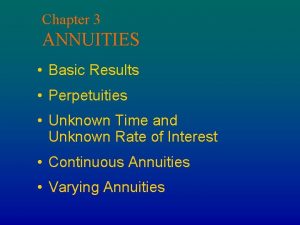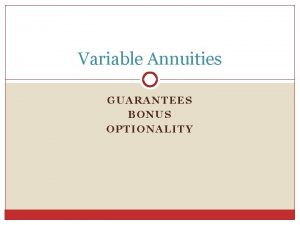Trieschmann Hoyt Sommer Retirement Planning and Annuities Chapter


























- Slides: 26

Trieschmann, Hoyt & Sommer Retirement Planning and Annuities Chapter 18 © 2005 Southwestern © 2005, Thomson/South-Western

Chapter Objectives • Give examples of situations in which an annuity might be an appropriate personal risk management tool • Explain the two elements of an annuity certain and the three elements of an annuity based on one or more persons’ lives • Distinguish among three different ways of paying for annuity contracts • Explain the difference between immediate and deferred annuities 2

Chapter Objectives • Identify and discuss the relevant factors determining the size of benefits payable under a joint and survivor annuity • List and explain three minimum guarantees that can be added to life annuities • Discuss the concept and structure of a variable annuity • Describe the process for calculating the federal income tax payable on a benefit paid out under a life annuity 3

Introduction • Different degrees of uncertainty usually exist regarding how long individuals will need the income that is to be provided by their savings – Particularly if the income will be needed throughout the retirement years • Retirement income for most individuals consists of funds from three different sources – Social Security – One or more employer-sponsored retirement plans – Personal savings • Financial planners sometimes referred to a “three-legged stool” approach – To emphasize the critical importance of all three income sources 4

Figure 18 -1: Three-Legged Stool Approach to Retirement Planning 5

Introduction • If investment earnings alone will not provide sufficient retirement income – Periodic withdrawals from the principal will be required – Under such circumstances, individuals living to advanced ages may outlive their income sources • Results in the need for a systematic means for liquidating resources • Together with a means for protecting against the risk of living beyond one’s financial resources – A product that can be arranged to meet these needs is known as an annuity 6

Introduction • An annuity is a contract that provides for the liquidation of a sum of money through a series of payments during a specified period of time – Often the period coincides with the lifetime of one or more persons – The person receiving the payments (the annuitant) is protected against the risk of outliving his or her financial resources 7

Structure of Annuities • Are structured so that annuitants’ payments are composed of both interest earnings and a partial liquidation of principal • For contracts guaranteeing payments for as long as an annuitant is alive – Each payment consists not only of interest and principal but also of a third element called the survivorship benefit 8

How are Annuity Premiums Paid? • An annuity can be purchased with one lump-sum payment – Called a single-premium annuity • Or it can be purchased in installments over a period of years – Called an annual-premium annuity • Considerable latitude is allowed regarding the timing and amount of premiums – The installment arrangement is a flexible-premium annuity – The size of the eventual annuity benefit is a function of the accumulated premium dollars at the time the annuitant decides to begin collecting benefits • Many of the life insurance settlement options discussed in Chapter 16 are, in essence, single-premium annuities – The life insurance proceeds are used as the single premium to purchase a particular income stream described in the policy 9

When Do Benefits Begin? • Benefits can begin as soon as the annuity is purchased – And continue at specified intervals thereafter • Called an immediate annuity • Deferred annuity – Benefits are deferred until some future time – The particular time when benefits are to begin may or may not be specified ahead of time • If such a time is designated, changes usually can be made if desired 10

Annuity Certain • An annuity that is payable for a specified period of time – Without regard to the life or death of the annuitant • For example, benefits might be payable for exactly ten years – If the annuitant dies before all payments have been made • The remaining benefits continue to be paid to either the annuitant’s heirs or a secondary person named in the annuity contract • An annuity certain has no survivorship benefit – Payments consists entirely of interest earnings and liquidation of principal 11

Straight Life Annuity • Pays benefits only during the lifetime of the annuitant • If the annuitant dies the day after purchasing the annuity – There is no obligation for the insurer to return any of the purchase price – Rather, the money is used to provide the survivorship element of the payments made to those persons still living and collecting benefits • The older an annuitant is when benefits begin under a straight life annuity – The greater is the size of each periodic payment – Older persons can be expected to die before collecting as many annuity payments as their younger counterparts 12

Joint and Survivor Annuity • An annuity may be issued on more than one life • A common arrangement provides that the annuity payments will continue as long as either annuitant is alive • The periodic payment may be constant during the entire period – Or it may be arranged so that the amount of each payment is reduced on the death of the first annuitant • The size of the survivor’s benefit is often stated as a percentage of the joint benefit – Using the terminology joint and x percent survivor annuity • A joint and 100 percent survivor annuity would pay the same benefit regardless of whether one or two annuitants were still alive • A joint and 50 percent survivor annuity would pay the survivor only one-half of the joint benefit 13

Joint and Survivor Annuity • Assuming all other factors are the same, the greater the reduction in benefits when the first person dies – The larger will be the joint benefit while both persons live • Another important determinant of benefit’s size for joint and survivor annuities is age – Joint and survivor annuity benefits are more expensive at younger ages 14

Period-Certain Guarantees • Annuities based on the lives of one or more persons can be arranged so that, regardless of the life or death of the annuitant(s) – At least a minimum number of annuity payments is made • In general, a period-certain life annuity ceases payments when the later of the following events occurs – Death of the annuitant – Expiration of the minimum guarantee period 15

Period-Certain Guarantees • If an annuitant is relatively young, the addition of a period -certain guarantee to a life annuity will not have a large effect on the size of each annuity payment • The reason for the much greater effect on benefits at older ages is the increased likelihood that the periodcertain guarantee will be the factor governing the length of the payout period • It is more expensive at older ages to add a guarantee providing at least a minimum number of payments regardless of the annuitant’s life or death – The increased price for the guarantee is reflected in relatively lower benefits 16

Refund Guarantees • Other arrangements to ensure at least a minimum return from an annuity are the refund guarantees that can be added to straight life and joint and survivor annuities • When a straight life annuity has an installment refund guarantee – Benefits continue after the death of the annuitant until the combined benefits paid before and after death equal the original purchase price • With the cash refund guarantee – The difference between the total payments received in the original premium would be paid immediately in cash to the beneficiary – More expensive than the installment refund option because the insurer forfeits the right to earn interest on the money immediately refunded 17

Temporary Life Annuity • Rarely used • Pays benefits until the expiration of a specified period of years or until the annuitant dies – Whichever comes first • A temporary life annuity can be considered the opposite of a period-certain life annuity 18

Is the Contract Fixed or Variable? • Fixed annuity – An annuity that has a benefit expressed in terms of a stated dollar amount based on a guaranteed rate of return – In practice, the actual benefit paid under a fixed annuity may vary over time • If interest earnings, expenses, and/or mortality experience are better than what was assumed in computing the annuity premium • Market value-adjusted annuity – Sometimes referred to as the modified guaranteed annuity – Can be used with fixed deferred annuities to provide relatively higher minimal interest rate guarantees during the first several years after a contract is issued but before benefits begin 19

Is the Contract Fixed or Variable ? • Variable annuity – Benefit associated with a variable annuity is expressed in terms of annuity units – The value of each annuity unit fluctuates with the performance of a specified portfolio of investments • This causes the annuity income to fluctuate as well – General objective is to provide the annuitant with an income that fluctuates in dollar value • But remains reasonably constant in terms of purchasing power • To be successful, the investment portfolio underlying the variable annuity must increase in value when general price levels increase – In past years, variable annuities were invested almost exclusively in common stocks; however, today many different investment choices are available 20

Taxation of Annuity Benefits • In determining the income tax payable on annuity benefits – It would be unfair to tax the entire amount of benefits paid • Because each payment consist partly of a return of an individual’s principal • The general approach currently required is to exclude a portion of each annuity payment from federal income taxes – Until the sum of all of the excluded amounts equals exactly the original purchase price of the annuity • After that time, the entire amount of each annuity payment becomes fully taxable 21

Taxation of Annuity Benefits • The amount of each benefit that can be excluded from taxes is computed according to rules specified by the IRS – Publishes tables for use in computing the probable number of years that a person can be expected to live and thus continue to receive annuity benefits • See Table 18 -1 – For a straight life annuity with payments beginning at age 60, payments can be expected for 24. 2 years • Exclusion ratio – Fraction of each payment that can be excluded from income taxation 22

Table 18 -1: Expected Years to Receive the Straight Life Annuity 23

Tax Issues Before Benefits Begin • In recognition of their role as longer-term savings vehicles – Annuities usually do not produce taxable income for their owners until income benefits begin • Some annuities are participating and may pay dividends to their owners – If the owner of a deferred annuity receives a dividend before benefits begin • The dividend is considered to be a return of premium and is not subject to income taxation – If the dividend is received after annuity benefits begin • Dividends serve to increase the size of the periodic benefit and are taxed accordingly 24

Tax Issues Before Benefits Begin • One situation that may result in taxable income for an annuitant before benefits become payable – If the owner of a deferred annuity makes a partial withdrawal of funds • The withdrawal is treated as taxable income to the extent that the annuity value exceeds the total premiums paid – This rule was enacted to reduce the possibility that annuities might be used as short-term, temporary tax shelters • The tax law also says for withdrawals that occur before age 59. 5 a penalty tax of 10% may be added to the regular income tax payable on the withdrawal 25

Tax Issues Before Benefits Begin • Withdrawals associated with some circumstances are exempt from the additional penalty tax – Such as death, disability, etc. • The exemptions are few enough to cause many potential buyers of deferred annuities to think twice before committing the funds to such contracts at young ages – Unless an individual seriously intends to use the funds accumulating in a deferred annuity to help provide income during retirement • Alternative savings vehicles may be the better choice 26
 Keogh plan definition
Keogh plan definition Gcu annuity
Gcu annuity 5 year annuity factor
5 year annuity factor Annuities definition
Annuities definition Annuities bloomfield hills
Annuities bloomfield hills Annuity definition
Annuity definition Contoh anuitas bertumbuh
Contoh anuitas bertumbuh Livingston federal employee retirement planning
Livingston federal employee retirement planning Retirement planning warsaw
Retirement planning warsaw Planning for retirement windsor
Planning for retirement windsor Fresno county birth certificate
Fresno county birth certificate Hoyt's sector model
Hoyt's sector model Concentric zone
Concentric zone Hoyts sector model
Hoyts sector model Hoyt model
Hoyt model Cbd inner city outer city
Cbd inner city outer city Harris ullman model
Harris ullman model Hoyt sector model
Hoyt sector model Cassie hoyt nopixel
Cassie hoyt nopixel Pola keruangan kota
Pola keruangan kota Pola keruangan desa
Pola keruangan desa Brent brandenburg
Brent brandenburg Galactic city model
Galactic city model Latin american model
Latin american model Elfchen gedicht sommer
Elfchen gedicht sommer Flaggtider
Flaggtider Sommer stumpenhorst
Sommer stumpenhorst

















































